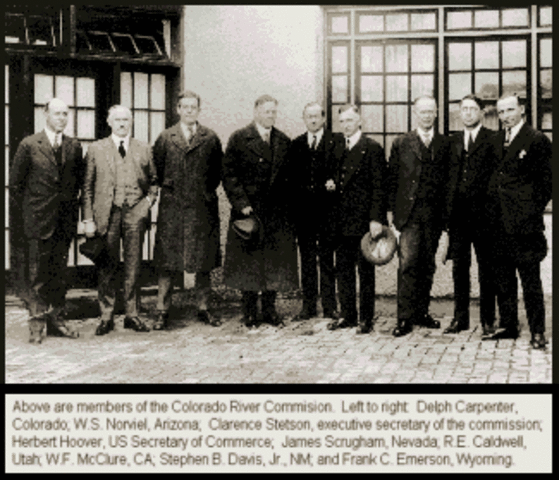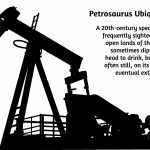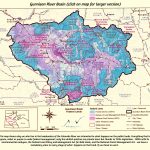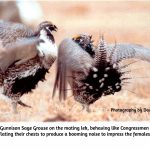
“Have you heard of the wonderful one-hoss shay,
That was built in such a logical way
It ran a hundred years to a day …
– Oliver Wendell Holmes
The last episode here ended with representatives of the seven Colorado River Basin states gathering in Washington, DC, as a commission charged, in the words of Herbert Hoover, U.S. Commerce Secretary and Chair of the Commission, ‘to consider and if possible to agree upon a compact between the seven states … providing for an equitable division of the water supply of the Colorado River and its tributaries amongst the seven states.’ He went on to note that ‘this Conference is unique in its attempt to determine states’ rights over so large an area by amiable agreement.’
That was in January 1922; in 2022 we commemorate the centennial of a compact created by the Commission and ratified by six of the seven states and the U.S. Congress, enabling the controlling and harnessing of the rambunctious Colorado River to commence. But this centennial comes in what is probably the worst year those depending on the Colorado River have ever experienced, at the end of the worst two consecutive decades for water in that century – or the past 12 centuries for that matter. ‘Drought’ has become a word of hope in the Southwest, because droughts end; most climatologists concur that the Southwest is mostly experiencing ‘aridification’ from climate change that is, for all practical purposes, permanent.
At the front end of that century, though, hopes were high that the use of the river’s water could be worked out so that, whatever major control structures were built on the river, favoring development by some over others, each state would be assured a share of the river’s water to develop in its own good time.
It is worth taking a moment to look at the seven commissioners and their chairman Herbert Hoover, then Secretary of Commerce. Four of the seven were State Engineers – W. F. McClure of California, Col. James Scrugham of Nevada, R.E. Caldwell of Utah, and Frank C. Emerson of Wyoming. Of the other three, Colorado’s Delph Carpenter was a water attorney, the Hon. Stephen B. Davis, Jr. of New Mexico was a judge, and W. S. Norviel was Arizona’s State Water Commissioner.
Chairman Hoover was also an engineer by training, with considerable experience globally. One might wonder why the Commerce Secretary was chosen as the federal representative rather than the Interior Secretary, but Hoover was actually asked to handle the task by Interior Secretary Albert Fall. Given his interest in such matters, one suspects Hoover might have invited the invitation….
An interesting factoid about the commissioners is that none of them called the natural Colorado River Basin home, with the exception of Arizona’s Norviel, who lived and worked in Phoenix, part of the Gila River Basin which drains most of Arizona (when there is anything to drain) and joins the Colorado River down near its delta. The Gila’s flows, however, are not officially counted in the waters divided by the Compact.
This ties in with another interesting factoid about the compact commission: none of the meeting to divide the use of the river’s waters were held within the river’s natural basin. The commissioners did make a trip through the basin in the summer of 1922, and held one public hearing on the river’s mainstem,in Grand Junction, Colorado; they also visited potential dam sites in the river’s lower canyon region. But basically the river’s future was decided in semi-closed meetings outside of the river’s natural basin – mostly in cities where eventually quite a bit of the river’s water went in tunnels and canals. One is reminded of the old political saying: If you aren’t at the table, you are on the menu.
Transcripts of all the Compact Commission meetings are available online, on the Western Water Assessment ‘Resources’ pages at the University of Colorado website (https://wwa.colorado.edu/resources/colorado-river-resources) and are interesting to read.
The commissioners began their work with seven January meetings in Washington, jumping right into discussion of the equitable division of the river’s waters. Some of the commissioners thought that the best way to try to allocate the river’s waters was on the basis of irrigable land in each state: how many acres of land could be irrigated in each state? Others thought it had to be based the amount of water each state would need to irrigate agricultural land – a quantity that increased with decreasing altitude and latitude due to evaporation. Colorado’s representative Delph Carpenter claimed that it was not necessary to set limits on the headwaters states; if they developed everything evelopable as fast as possible, nature would limit them before they’d used more than a large fraction of the water, allowing most of it to go on downstream.
They asked the Bureau of Reclamation and the state engineers (including those not already on the commission) for data on existing and potentially irrigable acreage in each state. That information was compiled by the sixth meeting that week in Washington, and it proved – interesting.
The Bureau estimated that the seven states plus Mexico already had 2.65 million acres of land under irrigation, with another 4.27 million that could be irrigated, for a potential total of 6.92 million acres. Calculating consumptive use of water to irrigate all of that acreage came to 17.45 million acre-feet (maf) – conveniently right on the mark of 17.3 maf, the 20-year average flow of the Colorado River as roughly measured at a Yuma gauge.
But that chart was countered with one presenting the state’s estimates of how much land they had left to develop agriculturally. Their estimate of existing acreage under irrigation was more or less in the same ballpark as the Bureau’s estimate – 2.95 million acres compared to 2.65 million. But their estimates for irrigable land yet to be developed in the future was a lot more optimistic than the Bureau’s – 7.81 million acres, close to twice the Bureau’s estimate. That much land under irrigation would have consumed 23.71 maf of water annually – a third more than the estimates of the river’s flow from the Yuma gauge.
The transcripts of the meetings don’t note thoughtful silences, but the presentation of those numbers must have precipitated one. Wyoming’s state engineer Frank Emerson then said that his state would probably accept the Bureau’s estimate if the other states would do the same. But Wyoming’s future estimate was only 37,000 acres higher than the Bureau’s; most of the others were two to four times the Bureau estimates, so none of the other states wanted to follow Wyoming’s example.
A note on the Bureau’s set of figures cautions that ‘all data involve estimation in varying degrees.’ Some of the degrees of estimation may have involved the aforementioned ‘Hassayampa microbe,’ then still pervasive in the waters of the River of Color, causing the drinkers to ‘no more see fact as naked fact, but all radiant with the color of romance.’ There was unquestionably a lot of the enthusiasm and optimism that colored the early 20th century, the age of the ‘can-do’ engineer, the dawn of the Anthropocene Epoch when we would ‘rationalize’ nature.
At the last meeting in Washington, the day after the presentation of the data, the commissioners considered ideas for either adjusting the data to fit the river, or collecting more, and more accurate, data, or just proceeding in development for 20 years or so and seeing if there was need then for a compact (Arizona’s idea). Delph Carpenter of Colorado believed that if every state limited itself to developing half of the water in their state, then there would be no problem with in-state development and plenty of water going on to downstream states. The downstream states disliked that idea.
Nevada’s engineer James Scrugham finally lost patience with the whole process, registering a protest against the idea that the function of the commission was to work up the technical data: ‘We are here,’ he said,’ to formulate a broad constructive policy for development which necessitates breadth of view and team work in action. I am opposed to the policy of spending several months time in getting information on small details.’
Toward the end of that seventh meeting, several members wondered if there was any reason to continue with further meetings. Hoover, seeing his vision of great engineering solutions being buried under the unknowable details of the future, practically pleaded with the commissioners: ‘It would seem a great misfortune if we dissolved the Commission without at least agreeing upon so primary a necessity as a control reservoir.’ He echoed Scrugham’s observation: ‘We ought not to let this meeting break up without bringing in a broad visioned constructive plan in general terms so as to advance the whole subject, at the same time not asking anyone to commit himself as to water division.’
The seven commissioners weren’t able to achieve that ‘broad constructive policy for development,’ but they agreed to reconvene after a couple months of discussion with people in their home states.
Hoover reconvened them in March for three weeks of public engagement around the Colorado River region – an adventure that began with public hearings and a commission meeting in Phoenix in mid-March, then to the village of Las Vegas and the canyon country to look at possible dam sites, then on to hearings in Los Angeles, then to Salt Lake City, and over into the upper river region for hearings in Grand Junction, then on to Denver for both hearings and a short commission meeting, and finally up to Cheyenne for hearings in early April.
During this period there were, as one would expect, informal discussions about their charge, and a new idea for dividing the use of the river’s waters emerged from the upper basin state commissioners: rather than pursuing the apparent ‘mission impossible’ of an equitable division according to irrigable land in each state, they might utilize a natural division in the river basin – the canyon region between the developing lands in the mountains and piedmont above the canyon, and the developing lands in the deserts below the canyon – to divide the use of the water equitably between the states above the canyons and the states below the canyons.
Chairman Hoover finally managed to reassemble the Compact Commission in November, to ‘do or die’ – do a compact or let the idea die. At the upscale resort of Bishop’s Lodge near Santa Fe – comped by the owner, a Denver developer – the commissioners participated, along with an ever-changing supporting cast of state governors, engineers, and Bureau of Reclamation officials, in an intensive charette of 18 meetings in 11 days, and created a Colorado River Compact that reflected the stress of working fast under their one-year deadline.
Commissioners Carpenter of Colorado and Caldwell of Utah brought up the concept of dividing the river basin into two basins: a four-state Upper Basin above the canyon region, and a three-state Lower Basin below the canyons, with each getting half of the river for its consumptive use. Considerable discussion followed with commissioners who thought it was an evasion of their charge to come up with an equitable division of the waters among the seven states – even though eventually all the commissioners, polled one by one by the Chair, agreed that they did not have enough knowledge for what Utah’s Caldwell called ‘the necessity of determining with exactitude the needs of the various and sundry states.’ The seven-state division acceptable to all was truly a ‘mission impossible.’
This two-basin division concept enabled them to proceed with a compact that five of the states accepted with no major reservations. California was happy with it because it achieved Scrugman’s and Hoover’s objective of creating ‘a broad constructive policy for development’ that would allow the federal government to proceed with Hoover’s vision of a big dam. The four Upper Basin states were happy because it gave them half the river’s water to develop in their own time, irrespective of what happened in California.
Arizona, however, was not happy with the concept. The Arizonans weren’t just envious of California’s fast growth; they wanted the same for themselves, and wanted enough water available to have it. And while the Upper Basin states were assured of no competition from the ‘800-pound gorilla’ downstream, the two-basin division put Arizona in the cage with the 800-pound gorilla. Their commissioner W.S. Norviel became a contrary presence in the meetings, undoubtedly pushed from behind by Arizona’s governor – a frequent onlooker at the Santa Fe meetings – and other forces at work in that desert state.
Nevada was in the same situation – in the cage with California – but there was practically nothing going on in Southern Nevada where the Colorado River touched the state. Commissioner Scrugham was based in Carson City in western Nevada, and more involved with development of the streams flowing off of the Sierras, to gradually disappear in the Great Basin. In the Washington meetings attempting the seven-state division based on acreages, the Bureau had estimated that Nevada had only 2,000 irrigable acres, while Scrugman had typically estimated on the high side: 82,000 acres. But even that was a pittance compared to the hundreds of thousands and millions of acres in the other six states’ estimates. Scrugham appeared contented that southern Nevada would benefit regardless if a big dam were built practically in its backyard.
That was the situation when the commissioners sat down in the hills above Santa Fe, far from the Colorado River itself, to negotiate the river’s future. ‘I think for a practical matter,’ said Caldwell of Utah, ‘we are almost making two rivers out of one in the Colorado River, to meet a practical situation.’
Next post, we will look at the compact they managed to come up with in those eleven days: an interstate agreement that, like Justice Holmes’ ‘wonderful one-hoss shay,’ has lasted one hundred years to the day – a compact that became the shaky infrastructure for a massive array of physical, political and legal structures laid over the Colorado River region that are currently showing serious cracks – not from the ‘drought’ alone….




Truly “mission impossible”:). Am looking forward to the next post.
Thanks George. Been a bit lazy about replying but enjoying “getting schooled” beyond my elementary education.
Vince
We all need to learn to live with a shrinking resource. Thanks George.
Interesting to learn of how the two-basin solution came about
I think Powell recommend that they divide the west into watersheds to avoid this problem. His advice was not followed.
Thanks, George, for this history of the Compact. Very interesting to compare the thoughts and predictions of those men at that time with today’s reality.
I also liked getting the bios and a photo of the characters.
Best, Paula
I live less than a mile from Bishop’s Lodge where this all took place. I knew Santa Fe had a lot of history but this was a part of it I did not know. Thanks George!
Once again, George, an interesting synopsis of politics awash in the red Colorado mud. Looking forward to your next post on the “outcome”?
Once again, George, an interesting synopsis of politics awash in the red Colorado mud. Looking forward to your next post on the “outcome”?
Won’t work in my backyard (NIMBY). Looking forward to the next post.
Oh, no, George! You slipped and wrote a filthy, nasty word.
I’m ready to grasp that this thing may get a LOT worse before it gets better. I even fear that generations of our western heritage was based on the idea that free and copious water flows would last forever and must be reviewed. But “PERMANENT?” (My caps).
Serious? Dire? But permanent?
I have never heard such utterances’ from a real scientist. In the science world, there is no such word.
Wash your computer keyboard out with soap.
Love ya, guy,
Keith
Well, Keith, thanks for catching me on that unscientific note. I did try to qualify it a little – permanent ‘for all practical purposes.’ In scientific reality, it may only be the next several centuries before natural and human efforts bring back the good old days of 300-350 parts of CO2 per million in the atmosphere, if natural and human forces decide that is a good thing to do…. But several centuries covers the next seven generations, which wiser souls say we should have been planning for…. ‘PERMANENT’ may not be the right word, but I’m still scratching for a better one…. ‘Adapt’ is the word that sums up ‘get used to it’….
It’s sort of mind-boggling, to read about these commissioners–no doubt a disparate lot–traveling to D.C. for seven meetings. I wonder if the magnificence of the capital city effected any thoughts of actions, if the very presence (if occasional) of the president gave the members the idea that what they were being asked to do would have ENORMOUS consequences for the future.
As always, I admire your writing, and, George, I encourage you to improve this undertaking by putting more of “yourself” into the writing. More of: “The transcripts of the meetings don’t note thoughtful silences, but the presentation of those numbers must have precipitated one.”
I love this–“the village of Las Vegas” and believe a brief history of Las Vegas’s outrageous–and suddenly sudden–growth would be helpful.
So, we can see that these commissioners were putting in the time–“an intensive charette of 18 meetings in 11 days, and created a Colorado River Compact that reflected the stress of working fast under their one-year deadline”–but does the line “an intensive charette of 18 meetings in 11 days, and created a Colorado River Compact that reflected the stress of working fast under their one-year deadline” indicate that what they came up with SHOULD HAVE BEEN SEEN AT THE TIME to be far short…or was the fact that all the statistics having been gathered in “wet years” finally the only true culprit?
What do you think about the two-basin division concept? I would like to know what you think about it, or if you don’t want to tell us what you think at this point, are you planning an ultimate “reveal” at the end?
At that time, “California was happy with it because it achieved Scrugman’s and Hoover’s objective of creating ‘a broad constructive policy for development’ that would allow the federal government to proceed with Hoover’s vision of a big dam. The four Upper Basin states were happy because it gave them half the river’s water to develop in their own time, irrespective of what happened in California.
“Arizona, however, was not happy with the concept. The Arizonans weren’t just envious of California’s fast growth; they wanted the same for themselves, and wanted enough water available to have it.”
And Arizona got it! I can hardly wait for the next chapter.
Your observations, anticipations and questions are all a preview of coming attractions and distractions. There’ll be at least one, maybe two more postings on the Compact, viewed from what the commissioners were trying to work out, and then from what that looks like today…. What they did and didn’t do – and did that they did not intend to do…. Thanks for the ‘deep reading’.
I fear that water will be taken away from alfalfa, cotton, and almond farmers, not to mention golf courses.